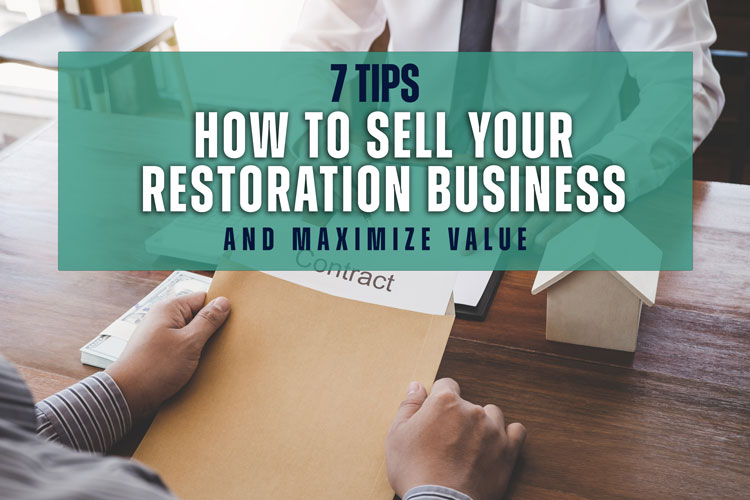Our clients consistently ask “How do I sell my restoration business?” Imagine coming home from work one day to find a real estate broker sitting in your driveway. They get out of the car, approach you, and politely make a cash offer to buy your house at the current market value. You, of course, tell them that your house is not for sale. The realtor persists and asks for a price that you would consider. You add 30% to their original offer and respond with a smile. They agree without objection and let you know they will draw up the paperwork. Feeling shocked and moderately confused, the scenario leaves you with one daunting question: Is this too good to be true?
While this fictitious scenario might seem like a pipe dream, it’s not too far from the reality experienced over the past couple of years in the restoration industry. Large national contractors, private equity groups, and venture capital firms have been in a race to acquire as many dots on the map as they can. And they are paying top dollar along the way. This often leaves many prime targets with the same question: Is this too good to be true?
The answer is no! It IS true and it can be VERY good if the deal is negotiated correctly. There are several elements to an M&A (Mergers and Acquisitions) deal that need to be understood and carefully considered when selling a restoration business. In addition to the technical details, how you approach the deal can have a very influential impact on the outcome. If you have been approached with an offer to buy, are considering a sale, or just want to gain greater insights on negotiating the sale of a business, here are 7 tips that can get you what you want from the deal and then some.
Selling Tips
1. Know What You Want
This is the first key concept we teach in negotiating effectively. It is also the first common mistake that many sellers make when they are approached unexpectedly with an offer. They simply do not take the time to figure out what their own needs, wants, and desires are from the sale. At VMA, we start by creating a matrix comprised of the top criteria in priority order, then we work with our clients to establish a range of options inside each. This serves as a guide for the seller moving forward that they can reference throughout the entire process, keeping what they want visible and in front of them at all times. This takes a little while to establish, but the benefits of the exercise can be measured in real dollars at the end of the deal.
2. Understand What Your Business is Worth
Gaining a true understanding of what a business is worth can be complex. Businesspeople toss multiples around like barstool banter. “I heard so and so sold their business for 5x, 7x, 10x earnings.” While there is a plethora of methods for valuing a company (Asset-Based, Market Value, Earnings Multiplier, etc.), the recommended method small business owners should really consider is based on the future value of cash flow or Discounted Cash Flow (DCF) method. The reason this is so important to small business owners is because most entrepreneurs engaged in service industries, such as restoration, started their business to maintain a lifestyle. While a big fat check today may seem attractive, it may pale in comparison to the future value of the cash flow that business could provide to the owner over time. Take this tip seriously because it provides a very strong basis for negotiating with any buyer. And I have seen it provide a swing in purchase price in the millions of dollars when selling your restoration business.
3. Maximize Cash at Closing
This tip would seem obvious when selling a business. However, you might be surprised at how tempting a couple extra million dollars are when presented under the guise of an “Earn-out” or “Contingency Holdback.” Sellers dangle this carrot from strings that come in the form of employment agreements, EBITA performance goals, and key employee retention clauses. They are truly nothing more than “Golden Handcuffs.” While many of these are not impossible to attain, they have proven to be very difficult in reality, because they depend largely on the buyer’s ability to make the new ownership transition smoothly without major disruptions to staffing, processes, and procedures. This can be negotiated effectively by seeking security in respect to items that are tied to financial remedies for failure. This quid pro quo tactic can yield leverage for the seller to get more, if not all, of the proceeds of the sale at closing.
4. Define Working Capital Early
The textbook definition of working capital is the normalized amount of cash necessary to fund ongoing operations after the deal is closed. Most deals require the sellers to leave this cash in the business at closing. The simple equation used to determine this amount is: (Current Assets – Current Liabilities) +/- Work in Progress adjustment. To most logical thinkers, this is very clear. However, even the most level-headed individuals can get caught off guard and become emotional when they find out what the real figure looks like on paper. Focusing on the “normalization” of working capital is the best way to negotiate this and take the edge off the scenario. For some great tips on how to do this, see the following article for greater understanding of working capital: HERE
5. Carefully Consider Post-Acquisition Employment
It is very common for buyers to require the continued employment of the seller and key management staff post acquisition, if for nothing more than it should, theoretically, support a smooth transition. In reality, most sellers never reach their post-acquisition employment term. There are a multitude of causes for this that could consume an entire article in and of itself. For the sake of keeping it simple, let’s just say the seller’s employment post-closing is not a good way to provide security for either party, financial or otherwise. So, don’t place a whole lot of value in it.
6. Minimize Non-Compete Restrictions
Any buyer who is making a significant financial investment in purchasing a service business is going to require a Non-Compete to be executed by the seller as a contingency of the deal. They have to protect their investment from the risk of the seller opening up shop down the road. While there is virtually no way to get around this, there are several details of a Non-Compete that can be negotiated. The most important are: term, geographic territory, services, and customer base. These criteria can be directly tied to the sell price and employment agreements and are negotiated during the due diligence phase of the deal.
7. Surround Yourself with Good Counsel
Flying solo on an M&A is possible, but it certainly is not advisable—especially when you consider what is on the line. Sure, there is the money, but aside from the financial stakes there are the livelihoods of those employed by the business, their families, and their futures. Not to mention your own. For these reasons, I would highly recommend assembling a team that consists of a Certified Public Accountant (CPA), an attorney who specializes in business law, and a Certified Financial Planner (CFP). In addition, sellers might consider an industry consultant, like Violand Management Associates, to provide coaching and assistance during the negotiation of the deal. If you are looking to market your company for sale, there are restoration industry-specific brokers like Exit Strategies 360 who can help you through the entire process, confidentially, from beginning to end.
Maximizing Your Restoration Business Value Before Sale
Whether you are on the seller’s side or the buyer’s side of the table, an M&A deal can be an exhilarating, yet daunting experience. Just like a real estate transaction, there are many elements to consider and ample opportunities to maximize the value you get from the deal. Service sector companies like restoration and cleaning have been, and will continue to be, hot targets for acquisition by many investors. Before you sign away your life’s work, do your research, take your time, and follow these tips. It’s a seller’s market and seller’s remorse is a real thing too!



